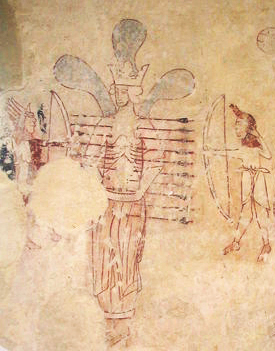
The Martyrdom of St. Edmund
14th century
Wall painting
St. Andrew's Church, Stoke Dry, England
Some lives of St. Edmund say he was martyred with javelins, but most images follow the tradition exemplified in Caxton's account and the Roman Breviary, where he is slain with arrows.1
The breviary and the Early South English Legendary emphasize the parallels between Edmund's death and Christ's. They add the detail that the pagans "direfully hided him with many stripes," the same torment visited upon Jesus before his execution. The Legendary says the pagans took the saint "just as Our Lord was led before Pilate," and the breviary concludes the lesson by saying that the saint "crowned with martyrdom the dying of the Lord Jesus, which he had so eminently borne in his body."2 This emphasis probably explains the way the artist has pictured the tree to which the saint was tied, which resembles a crucifix. The lower part of the riser can be seen beneath Edmund's feet and a trefoil-like pattern above suggests the crosspiece and the riser's upper part. The trefoil itself is an obvious symbol of the Trinity.
Read more about images of St. Edmund.
Sources:
Date and location information: Anne Marshall, "Martyrdom of St. Edmund, Stoke Dry, Rutland,"
Photograph: Tim Heaton via this page at Wikimedia Commons.
NOTES
1 Roman Breviary, IV, 753: The pagans "pierced the King's whole body with arrows, making breach upon breach."
2 Roman Breviary, ibid., 753-54. Early South English Legendary, 297-98.